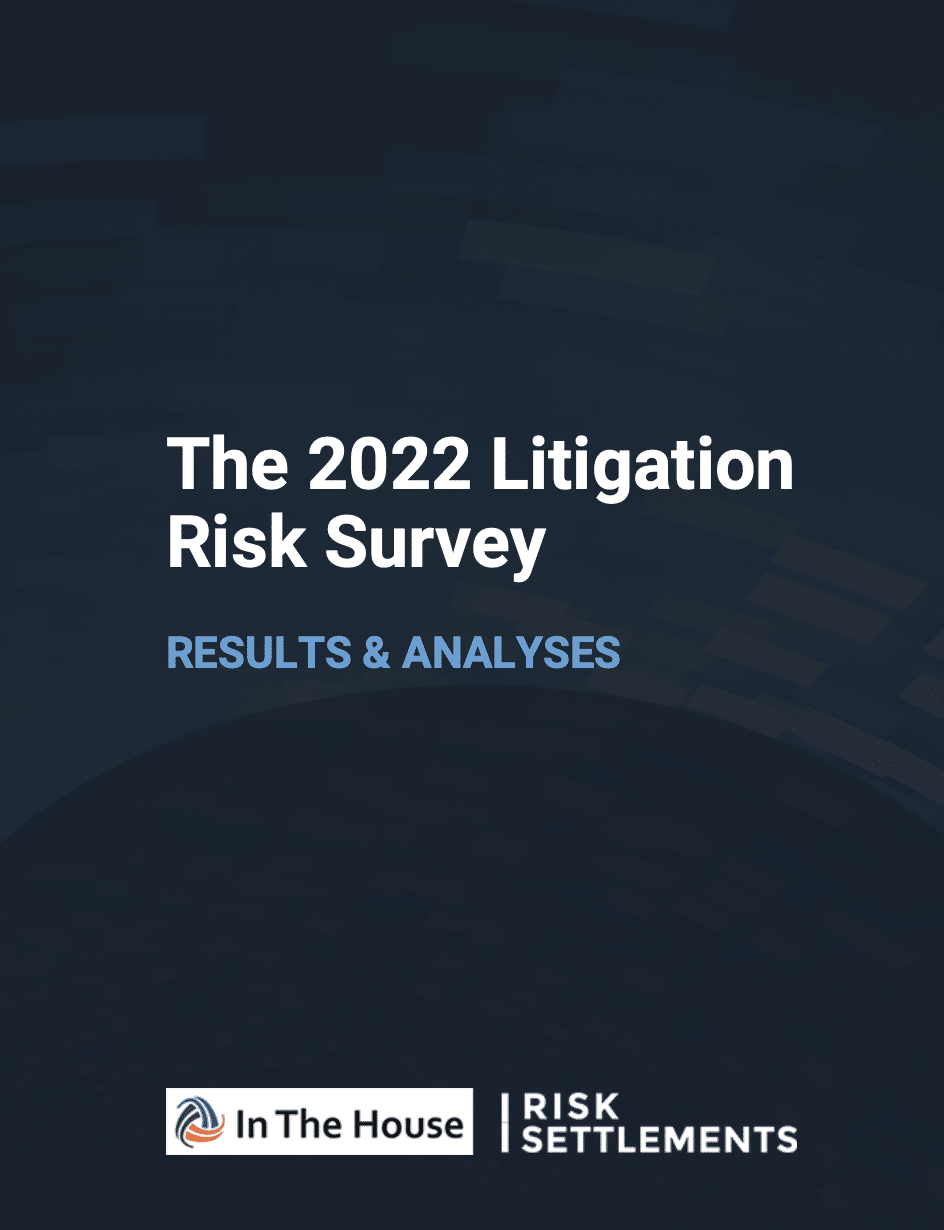September 26, 2022
Litigation Risk Survey Finds Large In-House Workloads, Tight Resources and Missed Opportunities to Transfer Risk


In-house legal departments say they are facing growing litigation burdens with limited staffing and financial resources—and yet most have not taken advantage of tools like risk transfer products to help manage workloads and ease budget uncertainty.
The 2022 Litigation Risk Survey, conducted by Risk Settlements in conjunction with In the House, asked general counsels and other in-house leaders around the globe about their litigation activities and legal spend, their tolerance for litigation risk, and their knowledge and use of the potential solutions available to help transfer the outcome risk of litigation.
The vast majority of in-house leaders—more than 80 percent—reported that their departments had 10 or fewer employees, and more than 70 percent said their legal budgets were less than $1 million. The results show that the size of the company and the size of the legal department do not necessarily correlate and provide further evidence that in-house lawyers and law departments are being stretched thin, particularly in the wake of the COVID-19 pandemic.
The survey also found that most in-house departments are bearing a substantial litigation workload. Three-quarters of respondents said they are currently defending active litigation, and 20 percent have 10 or more cases on the docket. Ten percent of respondents said they are fielding more than 50 active cases.
Perhaps unsurprisingly, given the tight budgets and small staffs, relatively few of the active cases are plaintiffs-side matters. Nearly half of respondents said they are currently pursuing no active affirmative litigation. And of the remaining respondents, the overwhelming majority are engaged in only a handful of plaintiffs-side matters.
In spite of their resource challenges, the majority of law departments have yet to take advantage of litigation risk transfer products. Most say, however, they are open to using them—particularly to gain greater budget certainty around costs. Two thirds of in-house counsel said they would consider using such products in their businesses in the future. This is especially true of products like litigation funding, adverse judgment insurance, and escrow release.
An effective claims monetization effort could assist GCs under pressure to transform their departments from cost centers into contributors to company profits. But less than a third of in-house leaders said their law departments are actively pursuing affirmative cases. If given the chance, however, nearly half—48 percent—would pursue claims if they were made aware of them, and 54 percent said they would be interested in pursuing affirmative cases regardless of the claim amount.
At present, most companies say they are attempting to locate affirmative claims themselves. Less than one-third are receiving help in identifying claims from outside counsel and only a handful are receiving the assistance of a litigation funder. The data suggests that companies should rely more heavily upon outside help to bring affirmative claims to their attention.
Nearly three-quarters of respondents said they were at least somewhat familiar with litigation funding. But only 5 percent say they have used funding themselves. In-house departments said they have identified funders primarily through referrals from business contacts. Half of the respondents reached out to funders directly or via funding brokers. Another third received referrals from outside counsel or were contacted by funders directly. An equal number of in- house counsel said the cost of funding and/or the structure of funding were the most important factors when choosing among funders.
Of the in-house counsel who have worked with a funder, the most common funding structure—used by 75 percent of respondents—was a contingency fee based upon the ultimate proceeds of a successful recovery. Hybrid structures, with claimants receiving funding via a combination of non-recourse loans and contingency fee arrangements, had also been used by two-thirds of respondents. Forty-four percent who have funded cases have arranged for a non-recourse loan, and 22 percent said they had used a recourse loan structure.
- Legal Ops. Three-quarters of respondents said their companies did not yet have a legal operations team. And while much of the conversation in the legal industry has been about the role of legal ops in selecting outside counsel, respondents who have legal ops capabilities ranked outside counsel selection last among their key priorities. More important, they said, were finance, technology and strategic planning.
- Litigation Risk. Fifty-four percent of respondents said they are “somewhat tolerant” of litigation risk. About a quarter of companies are “very tolerant” of risk. And a few—about 7 percent—say their companies are “extremely tolerant,” an answer that may suggest a few companies are leveraging affirmative litigation as a tool for revenue generation. Just over 16 percent—are “not tolerant at all” of litigation risk.
- Outside Counsel. In-house lawyers surveyed said expertise in the litigation being defended is the most important factor in the hiring process for outside counsel. A prior relationship with the law firm (or their inclusion as panel counsel) ranks second, respondents said. While cost is a consideration, as is the law firm’s flexibility on fees, only 8 percent of in-house leaders said these issues were at the top of their list when making an outside counsel hiring decision.
- Alternative Fee Arrangements. Alternative fee arrangements in litigation are occurring in about half (49 percent) of cases, the survey found. When they are used, AFAs are occurring more commonly in defense-side matters than in plaintiffs-side cases.
- Liability Insurance. Companies commonly have commercial liability insurance, but it is rare for them to actually use it to cover litigation costs. By a wide margin, respondents said they relied upon insurance less than 10 percent of the time. Only one in four said they relied upon insurance policies to cover 50 percent or more of their litigation costs.
- Assessing Risk. Assessing litigation risk remains a responsibility firmly in the hands of the general counsel, respondents said. Asked to rank the most important factors they use to assess risk in defense cases, in-house counsel said the “size of possible damages” and whether the matter is a “bet-the-company” case ranked first. The “likelihood of prevailing” in the case ranked second. When the company is considering bringing an action, however, the factors are reversed. By a wide margin, the likelihood of winning the case was the most important issue for in-house counsel when considering affirmative claims.
Responses to the 2022 Litigation Risk Survey came from in-house counsel in 20 countries, 37 U.S. states and the District of Columbia, and from more than 50 industry sectors.
Recent Content




